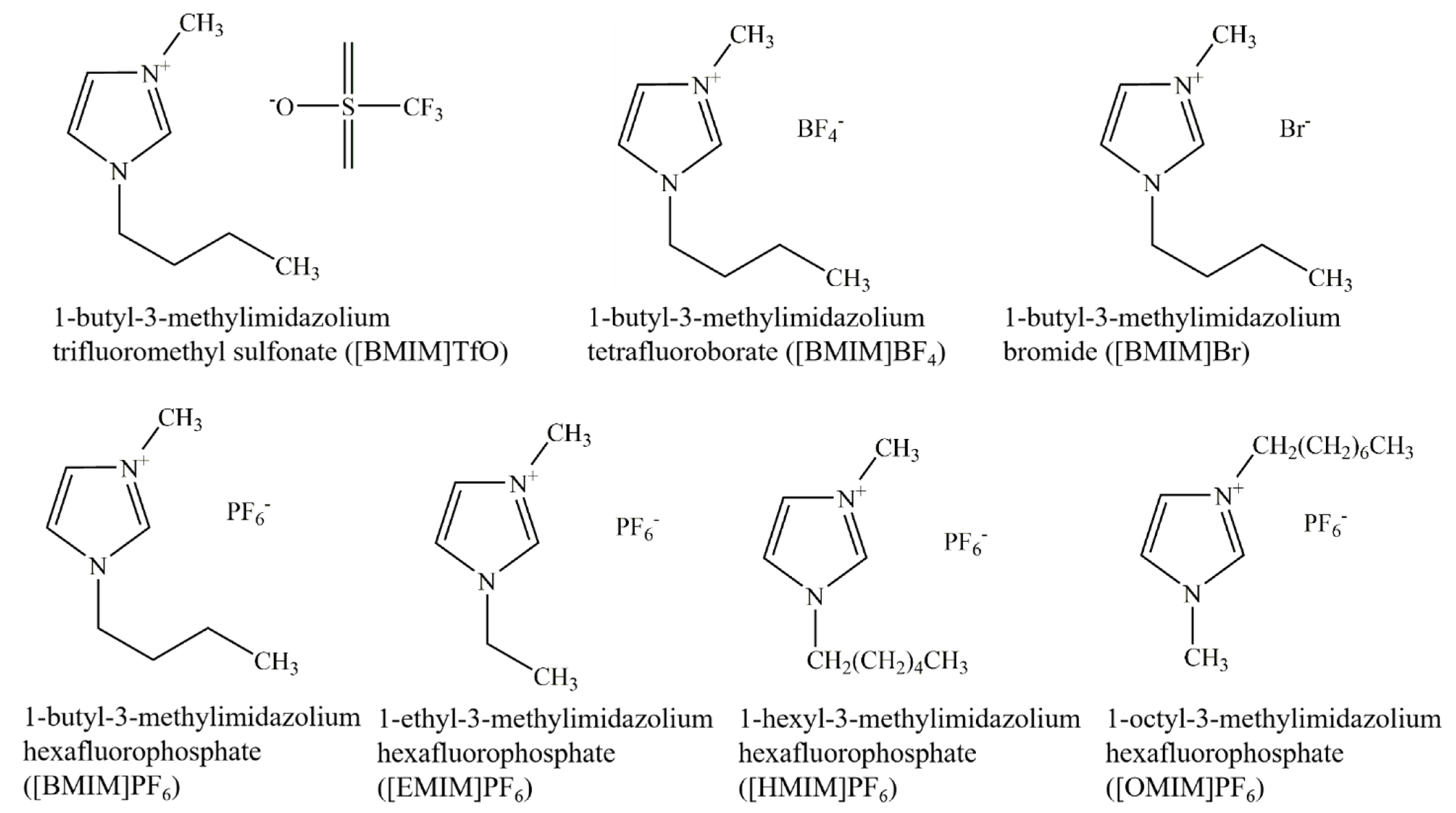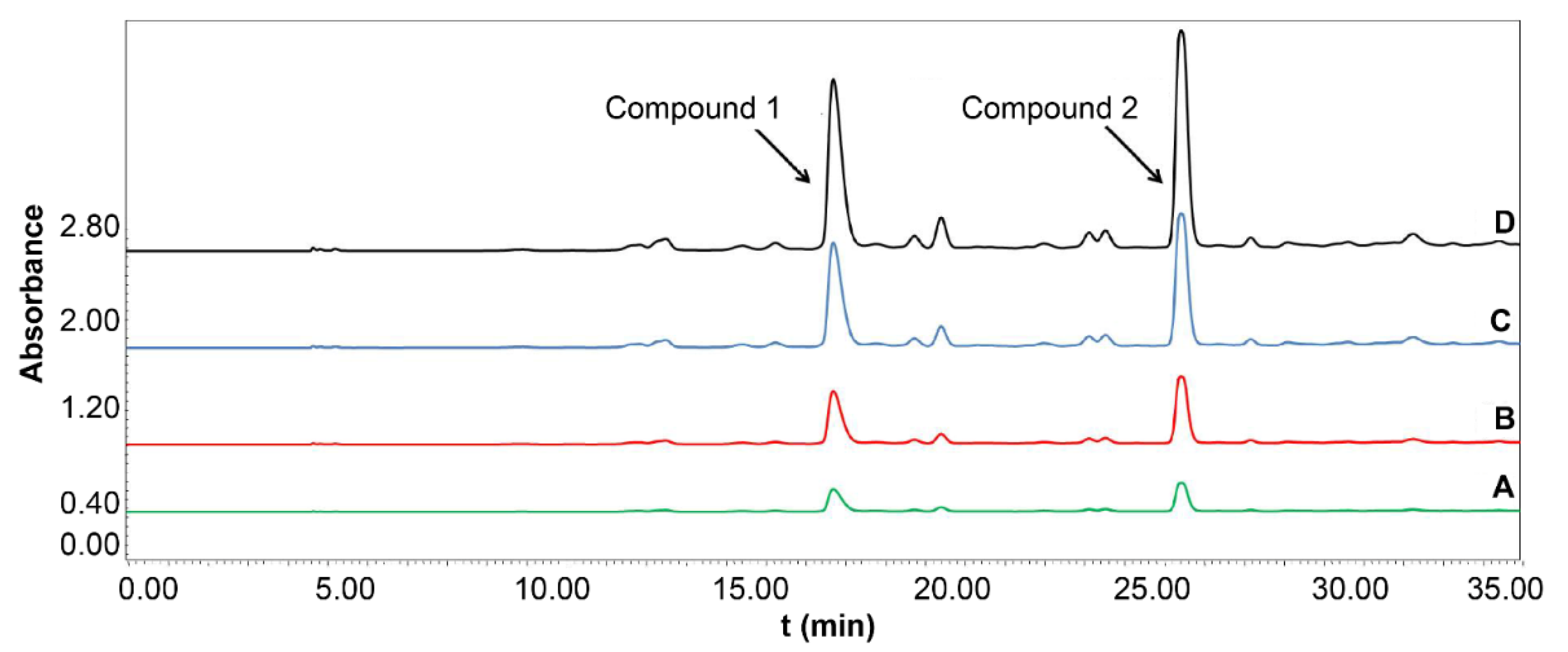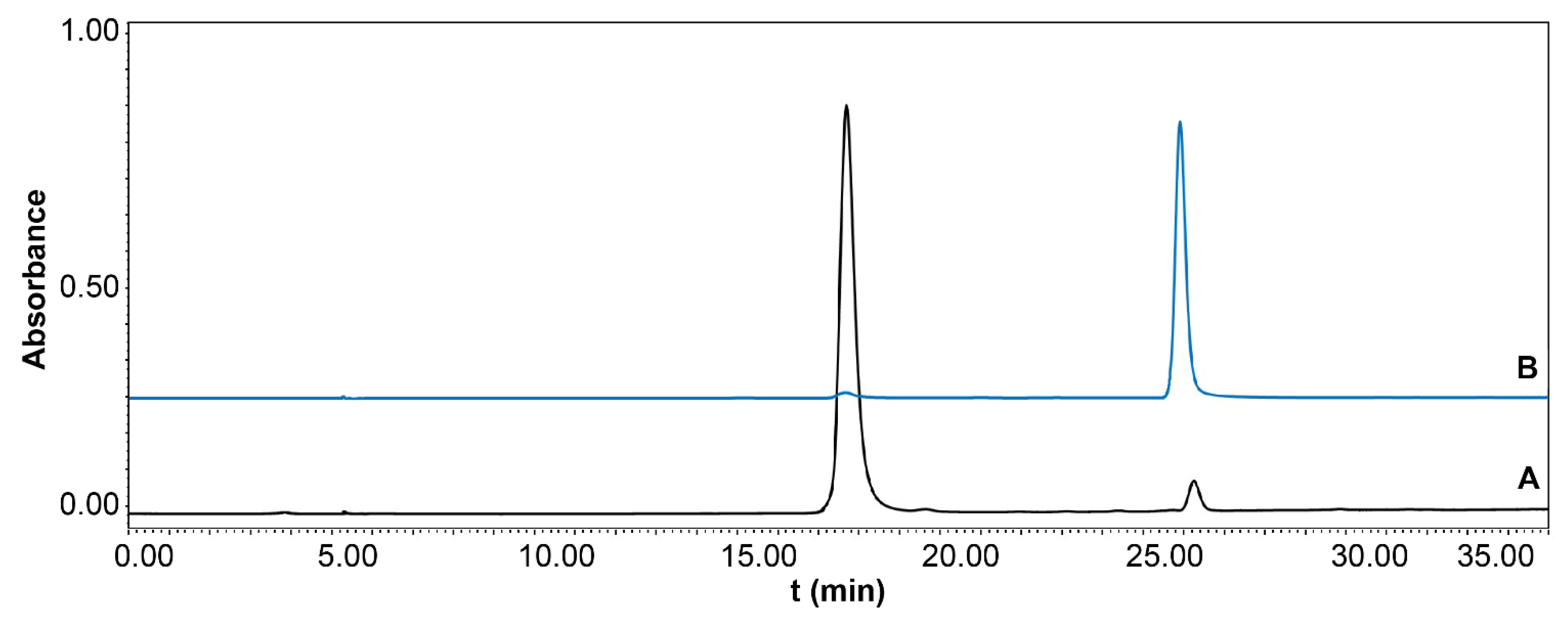Total Triterpenoid Extraction from Inonotus Obliquus Using Ionic Liquids and Separation of Potential Lactate Dehydrogenase Inhibitors via Ultrafiltration High-Speed Countercurrent Chromatography
Abstract
:1. Introduction
2. Results and Discussion
2.1. Single-Factor Experiments
2.1.1. Differences in Total Triterpenoid Content Extracted Using Seven IL Types
2.1.2. Effect of Dispersant Type on Total Triterpenoid Content
2.2. Effects of the Central Composite Design
2.3. Process Parameter Optimization and Model Validation
2.4. Evaluation of the Potential Inhibitory Activity of LDH
2.5. HSCCC Separation of Potential LDH Inhibitors from I. Obliquus
2.6. Purity Determination and Identification of Potential LDH Inhibitors Using High-Performance Liquid Chromatography (HPLC), Electrospray Ionization–Mass Spectrometry (ESI–MS), 1H Nuclear Magnetic Resonance (NMR), and 13C NMR
3. Materials and Methods
3.1. General Experimental Procedures
3.2. Chemicals and Reagents
3.3. Determination of Total Triterpenoids
3.4. Extraction of ILs
3.4.1. UAE
3.4.2. HAE
3.5. Process Level Screening
3.5.1. Single-Factor Experiment
Effect of IL Type on Total Triterpenoid Extraction
Effect of Dispersant Type on Total Triterpenoids
3.5.2. Optimization of the Central Composite Design
3.6. Statistical Analysis
3.7. Determination of the Potential Inhibitory Activity of LDH
3.8. High-Performance Liquid Chromatography-Diode Array Detector–Mass Spectrometry (HPLC–DAD–MS) Analysis
3.9. Separation of LDH Inhibitors by HSCCC
3.10. Analytical Data for Compounds 1 and 2
4. Conclusions
Author Contributions
Funding
Institutional Review Board Statement
Informed Consent Statement
Data Availability Statement
Conflicts of Interest
Sample Availability
References
- Zheng, W.; Zhang, M.; Zhao, Y.; Miao, K.; Jiang, H. NMR-based metabonomic analysis on effect of light on production of antioxidant phenolic compounds in submerged cultures of Inonotus obliquus. Bioresour. Technol. 2009, 100, 4481–4487. [Google Scholar] [CrossRef]
- Zhao, F.; Mai, Q.; Ma, J.; Xu, M.; Wang, X.; Cui, T.; Qiu, F.; Han, G. Triterpenoids from Inonotus obliquus and their antitumor activities. Fitoterapia 2015, 101, 34–40. [Google Scholar] [CrossRef]
- Wang, C.; Chen, Z.; Pan, Y.; Gao, X.; Chen, H. Anti-diabetic effects of Inonotus obliquus polysaccharides-chromium (III) complex in type 2 diabetic mice and its sub-acute toxicity evaluation in normal mice. Food Chem. Toxicol. 2017, 108, 498–509. [Google Scholar] [CrossRef]
- Wold, C.W.; Kjeldsen, C.; Corthay, A.; Rise, F.; Christensen, B.E.; Duus, J. Øllgaard; Inngjerdingen, K.T. Structural characterization of bioactive heteropolysaccharides from the medicinal fungus Inonotus obliquus (Chaga). Carbohydr. Polym. 2018, 185, 27–40. [Google Scholar] [CrossRef] [PubMed] [Green Version]
- Xu, X.; Wu, P.; Wang, T.; Yan, L.; Lin, M.; Chen, C. Synergistic effects of surfactant-assisted biodegradation of wheat straw and production of polysaccharides by Inonotus obliquus under submerged fermentation. Bioresour. Technol. 2019, 278, 43–50. [Google Scholar] [CrossRef]
- Baek, J.; Roh, H.-S.; Baek, K.-H.; Lee, S.; Lee, S.; Song, S.-S.; Kim, K.H. Bioactivity-based analysis and chemical characterization of cytotoxic constituents from Chaga mushroom (Inonotus obliquus) that induce apoptosis in human lung adenocarcinoma cells. J. Ethnopharmacol. 2018, 224, 63–75. [Google Scholar] [CrossRef] [PubMed]
- Kou, R.-W.; Han, R.; Gao, Y.-Q.; Li, D.; Yin, X.; Gao, J.-M. Anti-neuroinflammatory polyoxygenated lanostanoids from Chaga mushroom Inonotus obliquus. Phytochemistry 2021, 184, 112647. [Google Scholar] [CrossRef] [PubMed]
- Zou, C.X.; Dong, S.H.; Hou, Z.L.; Yao, G.D.; Lin, B.; Huang, X.X.; Song, S.J. Modified lanostane-type triterpenoids with neuroprotective effects from the fungus Inonotus obliquus. Bioorg. Chem. 2020, 105, 104438. [Google Scholar] [CrossRef]
- Nikitina, S.; Khabibrakhmanova, V.; Sysoeva, M. Composition and biological activity of triterpenes and steroids from Inonotus obliquus (chaga). Biomeditsinskaya Khimiya 2016, 62, 369–375. [Google Scholar] [CrossRef] [Green Version]
- Dehai, L.; Lingjuan, D.; Ning, K.; Jialin, G.; Zhanbin, W. Effect of extraction techniques on the extraction and hypolipidemic activity in vitro of triterpenoids from Inonotus hispidus. Food Sci. 2018, 39, 291–297. [Google Scholar]
- Wold, C.W.; Gerwick, W.H.; Wangensteen, H.; Inngjerdingen, K.T. Bioactive triterpenoids and water-soluble melanin from Inonotus obliquus (Chaga) with immunomodulatory activity. J. Funct. Foods 2020, 71, 104025. [Google Scholar] [CrossRef]
- Wu, T.; Liu, C.M.; Huang, Y.; Li, S.; Wang, Y. Simultaneous screening and isolation of activated constituents from Puerariae Flos by ultrafiltration with liquid chromatography and mass spectrometry combined with high-speed counter-current chro-matography. J. Sep. Sci. 2018, 41, 4458–4468. [Google Scholar] [CrossRef]
- Zhan, X.; Lv, B.; Yang, K.; Jing, G.; Zhou, Z. Dual-Functionalized Ionic Liquid Biphasic Solvent for Carbon Dioxide Capture: High-Efficiency and Energy Saving. Environ. Sci. Technol. 2020, 54, 6281–6288. [Google Scholar] [CrossRef] [PubMed]
- Liu, X.; Chen, P.; Wang, L.L.; Wang, C.J.; Zhao, M.Q.; Fu, J.H. Polydimethylsiloxane/ionic liquid sponge used in headspace solid-phase extraction coupled with GC–MS for rapid analysis of essential oil in lavender. Biomed. Chromatogr. 2021, 35, 4992. [Google Scholar] [CrossRef] [PubMed]
- Guilherme, J.; F’atima, J.; S´onia, P.M.V.; Fernando, J.M.G.; Jana, A.; Joana, L.P. New insights on the effects of ionic liquid structural changes at the gene expression level: Molecular mechanisms of toxicity in Daphnia magna. J. Hazard. Mater. 2021, 409, 124517. [Google Scholar]
- Moravcová, D.; Planeta, J.; King, A.W.; Wiedmer, S.K. Immobilization of a phosphonium ionic liquid on a silica monolith for hydrophilic interaction chromatography. J. Chromatogr. A 2018, 1552, 53–59. [Google Scholar] [CrossRef] [PubMed] [Green Version]
- Kulacki, K.J.; Lamberti, G.A. Toxicity of imidazolium ionic liquids to freshwater algae. Green Chem. 2007, 10, 104–110. [Google Scholar] [CrossRef]
- Biczak, R.; Pawłowska, B.; Bałczewski, P.; Rychter, P. The role of the anion in the toxicity of imidazolium ionic liquids. J. Hazard. Mater. 2014, 274, 181–190. [Google Scholar] [CrossRef]
- Wang, J.; Shi, D.F.; Zheng, M.Z.; Ma, B.; Cui, J.; Liu, C.M. Screening, separation, and evaluation of xanthine oxidase inhibi-tors from Paeonia lactiflora using chromatography combined with a multi-mode microplate reader. J. Sep. Sci. 2017, 40, 4160–4167. [Google Scholar] [CrossRef]
- Fang, Y.-X.; Song, H.-P.; Liang, J.-X.; Li, P.; Yang, H. Rapid screening of pancreatic lipase inhibitors from Monascus-fermented rice by ultrafiltration liquid chromatography-mass spectrometry. Anal. Methods 2017, 9, 3422–3429. [Google Scholar] [CrossRef]
- Liu, M.; Huang, X.; Liu, Q.; Li, X.; Chen, M.; Zhu, Y.; Chen, X. Separation of α-glucosidase inhibitors from Potentilla kleiniana Wight et Arn using solvent and flow-rate gradient high-speed counter-current chromatography target-guided by ul-trafiltration HPLC-MS screening. Phytochem. Anal. 2019, 30, 661–668. [Google Scholar] [CrossRef] [PubMed]
- Yang, X.-W.; Han, M.-H.; Jin, Y.-P. Studies on the chemical constituents from herba anoectochili. J. Chin. Med. Mater. 2007, 30, 797–800. [Google Scholar]
- Salimuzzaman, S.; Farrukh, H.; Sabira, B.; Siddiqui, B.S. Oleanderol, a new pentacyclic triterpene from the leaves of Nerium oleander. J. Nat. Prod. 1988, 51, 229–233. [Google Scholar]
- Kaur, A.; Singh, N.; Bhatti, M.S.; Bhatti, R. Optimization of extraction conditions of Angelica archangelica extract and activity evaluation in experimental fibromyalgia. J. Food Sci. 2020, 85, 3700–3710. [Google Scholar] [CrossRef] [PubMed]
- Medfai, W.; Contreras, M.D.M.; Lama-Muoz, A.; Mhamdi, R.; Castro, E. How cultivar and extraction conditions affect anti-oxidants type and extractability for olive leaves valorization. ACS Sustain. Chem. Eng. 2020, 8, 5107–5118. [Google Scholar] [CrossRef]
- Islam, M.N.; Jo, Y.-T.; Jeong, Y.-J.; Park, J.-H. Remediation approach for organic compounds and arsenic co-contaminated soil using the pressurized hot water extraction process. Environ. Technol. 2017, 40, 125–131. [Google Scholar] [CrossRef] [PubMed]
- Noorshamsiana, A.W.; Eliyanti, A.O.N.; Fatiha, I.; Astimar, A.A. A review on extraction process of lignocellulosic chemicals from oil palm biomass. J. Oil Palm Res. 2017, 29, 512–527. [Google Scholar]
- Volpp, M.; Holzgrabe, U. Determination of plasma protein binding for sympathomimetic drugs by means of ultrafiltration. Eur. J. Pharm. Sci. 2019, 127, 175–184. [Google Scholar] [CrossRef]
- Hou, W.; Li, S.; Li, S.; Shi, D.; Liu, C. Screening and isolation of cyclooxygenase-2 inhibitors fromTrifolium pratense L. via ultrafiltration, enzyme-immobilized magnetic beads, semi-preparative high-performance liquid chromatography and high-speed counter-current chromatography. J. Sep. Sci. 2019, 42, 1133–1143. [Google Scholar] [CrossRef]
- Li, S.N.; Tang, Y.; Liu, C.M.; Li, J.; Guo, L.P.; Zhang, Y.C. Development of a method to screen and isolate potential xanthine oxidase inhibitors from Panax japlcus var via ultrafifiltration liquid chromatography combined with counter-current chromatography. Talanta 2015, 134, 665–673. [Google Scholar] [CrossRef]







| No. | Factor | Total Triterpenoids (mg) | |||
|---|---|---|---|---|---|
| A | B | C | UAE | HAE | |
| 1 | 0 | 0 | 0 | 8.708 | 10.090 |
| 2 | +1.682 | 0 | 0 | 8.500 | 15.446 |
| 3 | 0 | 0 | 0 | 8.708 | 10.090 |
| 4 | 0 | −1.682 | 0 | 4.285 | 12.301 |
| 5 | −1 | −1 | −1 | 8.271 | 9.147 |
| 6 | 0 | 0 | 0 | 8.708 | 10.090 |
| 7 | 0 | +1.682 | 0 | 8.846 | 12.716 |
| 8 | −1.682 | 0 | 0 | 6.220 | 9.537 |
| 9 | +1 | +1 | −1 | 7.523 | 10.569 |
| 10 | −1 | −1 | +1 | 7.492 | 7.979 |
| 11 | −1 | +1 | +1 | 9.536 | 9.147 |
| 12 | −1 | +1 | −1 | 7.590 | 7.395 |
| 13 | 0 | 0 | +1.682 | 6.911 | 10.781 |
| 14 | +1 | +1 | +1 | 11.823 | 11.823 |
| 15 | 0 | 0 | 0 | 8.708 | 10.090 |
| 16 | +1 | −1 | +1 | 5.016 | 9.852 |
| 17 | 0 | 0 | 0 | 8.708 | 10.090 |
| 18 | 0 | 0 | 0 | 8.708 | 10.090 |
| 19 | +1 | −1 | −1 | 6.270 | 10.569 |
| 20 | 0 | 0 | −1.682 | 5.943 | 7.602 |
| Source | Sum of Squares | Df | Mean Square | F Value | p | Significant |
|---|---|---|---|---|---|---|
| UAE | ||||||
| Model | 45.82 | 9 | 5.09 | 5.35 | 0.0075 | Significant |
| A–Solid:liquid ratio | 0.18 | 1 | 0.18 | 0.19 | 0.6711 | |
| B–Concentration of the extraction solution | 21.4 | 1 | 21.4 | 22.47 | 0.0008 | |
| C–Extracting time | 2.5 | 1 | 2.5 | 2.62 | 0.1363 | |
| AB | 5.61 | 1 | 5.61 | 5.89 | 0.0357 | |
| AC | 0.44 | 1 | 0.44 | 0.46 | 0.5114 | |
| BC | 8.57 | 1 | 8.57 | 9 | 0.0133 | |
| A2 | 0.62 | 1 | 0.62 | 0.66 | 0.4372 | |
| B2 | 3.45 | 1 | 3.45 | 3.62 | 0.0863 | |
| C2 | 4.17 | 1 | 4.17 | 4.38 | 0.0628 | |
| Residual | 9.52 | 10 | 0.95 | |||
| Lack of Fit | 9.52 | 5 | 1.9 | |||
| Pure Error | 0 | 5 | 0 | |||
| Cor Total | 55.34 | 19 | ||||
| Fitting equations | Y = 8.67 + 0.12A + 1.25B + 0.43C + 0.84AB + 0.23AC + 1.03BC − 0.21A2 − 0.49B2 − 0.54C2 (R2 = 0.8279) | |||||
| HAE | ||||||
| Model | 48.57 | 9 | 5.4 | 3.54 | 0.0308 | Significant |
| A—Solid-liquid ratio | 26.66 | 1 | 26.66 | 17.49 | 0.0019 | |
| B—Concentration of the extraction solution | 0.32 | 1 | 0.32 | 0.21 | 0.6575 | |
| C—Extracting time | 3.06 | 1 | 3.06 | 2.01 | 0.1868 | |
| AB | 0.82 | 1 | 0.82 | 0.54 | 0.4812 | |
| AC | 2.76 × 10−4 | 1 | 2.76 × 10−4 | 1.81 × 10−4 | 0.9895 | |
| BC | 2.99 | 1 | 2.99 | 1.96 | 0.1916 | |
| A2 | 2.85 | 1 | 2.85 | 1.87 | 0.2015 | |
| B2 | 2.93 | 1 | 2.93 | 1.92 | 0.196 | |
| C2 | 7.51 | 1 | 7.51 | 4.93 | 0.0507 | |
| Residual | 15.24 | 10 | 1.52 | |||
| Lack of Fit | 15.24 | 5 | 3.05 | |||
| Pure Error | 0 | 5 | 0 | |||
| Cor Total | 63.81 | 19 | ||||
| Fitting equations | Y = 10.15 + 1.40A + 0.15B + 0.47C + 0.32AB − 5.875 e− 003AC + 0.61BC + 0.44A2 − 0.45B2 − 0.72C2 (R2 = 0.7611) | |||||
| Solvent System (v/v) | Compound 1 (K1) | Compound 2 (K2) | K1/K2 |
|---|---|---|---|
| 1:1:1:1 | 0.42 | 0.85 | 0.49 |
| 5:5:3:7 | 1.29 | 0.99 | 1.30 |
| 1:1:2:2 | 7.58 | 2.73 | 2.78 |
| Factor | Level | ||||
|---|---|---|---|---|---|
| −1.682 | −1 | 0 | +1 | +1.682 | |
| A (solid-liquid ratio) | 10 | 14.055 | 20 | 25.945 | 30 |
| B (concentration of the extraction solution, mol/L) | 0.1 | 0.282 | 0.55 | 0.818 | 1 |
| C (extracting time, min) | 15 | 32.232 | 57.5 | 82.767 | 100 |
| Compound 1 | Compound 2 | |
|---|---|---|
| Name | Betulin22 | Lanosterol23 |
| Retention time-tR (min) | 17.98 | 26.17 |
| ESI–MS (+) m/z | 442 [M]+ | 426 [M]+ |
| Molecular formula | C30H50O | C30H50O |
| 1H-NMR (400 MHz, CDCl3) δ | 0.75 (3H, s, H-24), 0.82 (3H, s, H-25), 0.96 (3H, s, H-23), 0.97 (3H, s, H-27), 1.02 (3H, s, H-26), 1.68 (3H, s, H-30), 3.18 (1H, dd, J = 11.2, 4.8 Hz, H-3), 3.31 (1H, d, J = 10.8 Hz, H-28α), 3.78 (1H, d, J = 10.8 Hz, H-28β), 4.58 (1H, s, H-29α), 4.68 (1H, s, H-29β) | 0.68 (3H, s, H-30), 0.80 (3H, s, H-18), 0.87 (3H, d, J = 6.5 Hz, H-21), 0.90 (3H, s, H-28), 0.99 (3H, s, H-19), 1.03 (3H, s, H-29), 1.60 (3H, s, H-27), 1.68 (3H, s, H-26), 3.21 (1H, dd, J = 3.4, 9.3 Hz, H-3), 5.08 (1H, t, J = 5.2 Hz, H-24) |
| 13C-NMR (100 MHz, CDCl3) δ | 38.6 (C-1), 27.3 (C-2), 79.0 (C-3), 38.8 (C-4), 55.2 (C-5), 18.3 (C-6), 34.2 (C-7), 40.9 (C-8), 50.3 (C-9), 37.1 (C-l0), 20.8 (C-11), 25.1 (C-12), 37.2 (C-13), 42.7 (C-14), 27.0 (C-15), 29.1 (C-16), 47.7 (C-17), 47.7 (C-18), 48.7 (C-19), 150.5 (C-20), 29.7 (C-21), 33.9 (C-22), 27.9 (C-23), 15.3 (C-24), 16.1 (C-25), 15.9 (C-26), 14.7 (C-27), 60.5 (C-28), 109.7 (C-29), 19.0 (C-30) | 36.3 (C-1), 28.2 (C-2), 79.0 (C-3), 38.9 (C-4), 50.9 (C-5), 21.0 (C-6), 27.8 (C-7), 134.3 (C-8), 134.3 (C-9), 37.0 (C-10), 18.2 (C-11), 26.5 (C-12), 44.4 (C-13), 49.8 (C-14), 30.9 (C-15), 30.8 (C-16), 50.3 (C-17), 15.4 (C-18), 18.6 (C-19), 36.2 (C-20), 19.1 (C-21), 35.3 (C-22), 25.7 (C-23), 125.2 (C-24), 130.9 (C-25), 24.9 (C-26), 17.6 (C-27), 24.2 (C-28), 27.9 (C-29), 15.7 (C-30) |
Publisher’s Note: MDPI stays neutral with regard to jurisdictional claims in published maps and institutional affiliations. |
© 2021 by the authors. Licensee MDPI, Basel, Switzerland. This article is an open access article distributed under the terms and conditions of the Creative Commons Attribution (CC BY) license (https://creativecommons.org/licenses/by/4.0/).
Share and Cite
Wang, Y.; Guo, L.; Liu, C.; Zhang, Y.; Li, S. Total Triterpenoid Extraction from Inonotus Obliquus Using Ionic Liquids and Separation of Potential Lactate Dehydrogenase Inhibitors via Ultrafiltration High-Speed Countercurrent Chromatography. Molecules 2021, 26, 2467. https://doi.org/10.3390/molecules26092467
Wang Y, Guo L, Liu C, Zhang Y, Li S. Total Triterpenoid Extraction from Inonotus Obliquus Using Ionic Liquids and Separation of Potential Lactate Dehydrogenase Inhibitors via Ultrafiltration High-Speed Countercurrent Chromatography. Molecules. 2021; 26(9):2467. https://doi.org/10.3390/molecules26092467
Chicago/Turabian StyleWang, Yueqi, Liping Guo, Chunming Liu, Yuchi Zhang, and Sainan Li. 2021. "Total Triterpenoid Extraction from Inonotus Obliquus Using Ionic Liquids and Separation of Potential Lactate Dehydrogenase Inhibitors via Ultrafiltration High-Speed Countercurrent Chromatography" Molecules 26, no. 9: 2467. https://doi.org/10.3390/molecules26092467





